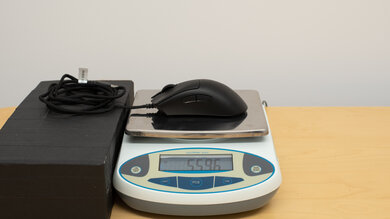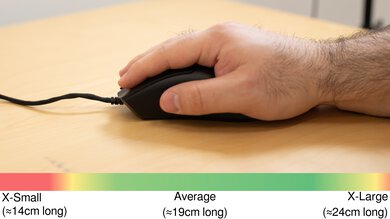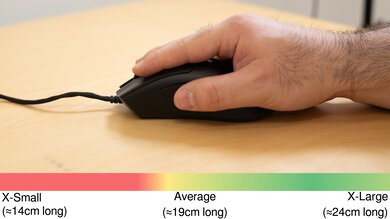The Razer DeathAdder V3 is a lightweight, wired gaming mouse in Razer's DeathAdder lineup. This mouse has a right-handed shape and is best suited for medium or larger-sized hands. Compared to the previous generation Razer DeathAdder V2, this mouse has a slightly different shape and is significantly more lightweight. It also features several significant performance upgrades, including a new sensor, a new generation of optical switches, and native support for a higher maximum polling rate of 8000Hz.
Our Verdict
The Razer DeathAdder V3 is adequate for office work, though it isn't designed specifically for this use. It feels well-built, has a comfortable right-handed shape, and you can reprogram all of the buttons using the customization software. Unfortunately, it's a wired-only model, which adds cable clutter to your desk, and its scroll wheel lacks a free scrolling mode and left and right tilt inputs.
-
Excellent build quality.
-
Wired-only.
-
Cable retains some minor kinking from the way it's packaged.
The Razer DeathAdder V3 is an outstanding FPS gaming mouse. It's extremely lightweight and feels sturdy. Its ergonomic right-handed shape is comfortable, especially with a palm or claw grip for medium or larger-sized hands. Its feet also glide exceptionally smoothly on mousepads and desks. However, while it has a very lightweight and flexible cable, it does retain some kinks from its packaging. Performance-wise, it has exceptionally low and consistent click latency, superb sensor performance, and a maximum polling rate of 8000Hz, providing an extremely responsive-feeling gaming experience.
-
Remarkably low click latency.
-
Extremely lightweight.
-
Excellent build quality.
-
Cable retains some minor kinking from the way it's packaged.
The Razer DeathAdder V3 is an impressive mouse for MMO gaming, but it doesn't have nearly as many side buttons as a dedicated MMO gaming model. It feels sturdy and has a comfortable right-handed shape suitable for medium or larger-sized hands. It also has remarkably low latency, a maximum polling rate of 8000Hz, and outstanding all-around sensor performance.
-
Remarkably low click latency.
-
Extremely lightweight.
-
Excellent build quality.
-
Cable retains some minor kinking from the way it's packaged.
-
Not nearly as many buttons as a dedicated MMO gaming mouse.
The Razer DeathAdder V3 has exceptional raw performance. It has remarkably low click latency and a maximum polling rate of 8000Hz, which means it sends information to your computer eight times more frequently than most gaming mice using a standard polling rate of 1000Hz. At the same time, its sensor provides remarkably consistent motion and accuracy performance that closely translates the physical movements you make with your mouse into the cursor movements you see on-screen.
-
Remarkably low click latency.
-
Supports a maximum polling rate of up to 8000Hz.
-
Outstanding sensor performance.
-
Cable retains some minor kinking from the way it's packaged.
- 6.4 Work
- 9.3 Video Games (FPS)
- 8.1 Video Games (MMO)
- 9.6 Raw Performance
Changelog
- Updated Jul 25, 2024: We've added a link to the newly-reviewed GLORIOUS Model D 2 to the Style section of this review.
- Updated Feb 29, 2024: We've added notes to indicate our tested polling rate settings in the Click Latency, CPI, and Sensor Latency sections.
- Updated Jan 05, 2024: We've updated the CPI graph displayed in the Sensor Latency section of this review. Our results remain the same, but these graphs have two new columns with results from the Delay At Half Movement and Delay To End Of Movement tests.
- Updated Nov 24, 2023: We've converted this review to Test Bench 1.5. This update adds a new Main Button test group, which provides button actuation data and switch information. We've also made minor changes to how we calculate the Office usage score. For more details, you can see our full changelog here.
- Updated Sep 26, 2023: We previously incorrectly stated that this mouse works on glass when, in fact, it doesn't. The review has been updated to reflect this change.
Check Price
Differences Between Sizes And Variants
The Razer DeathAdder V3 is only available in a black colorway. While there are no variants currently available, there is a wireless version of this mouse called the Razer DeathAdder V3 Pro. You can see the label for our unit here.
Compared To Other Mice
The Razer DeathAdder V3 continues Razer's popular DeathAdder lineup. This new version makes several improvements over the previous generation Razer DeathAdder V2, as it's much lighter, has a slightly modified shape, a new sensor, and Razer's newest optical switches. While this mouse shares the same shape as the significantly more expensive wireless Razer DeathAdder V3 Pro, it natively supports a maximum polling rate of 8000Hz, unlike the wireless V3 Pro, which has a maximum polling rate of 1000Hz (or 4000hz if you purchase the HyperSpeed USB Dongle). Altogether the DeathAdder V3 delivers some of the best gaming performance on the marketplace, edging out significantly more expensive wireless flagships, including the aforementioned wireless version of this mouse, the DeathAdder V3 Pro, the Razer Viper V2 Pro, or the Logitech G PRO X SUPERLIGHT.
For more recommendations, see our picks for the best wired mice, the best FPS mice, and the best lightweight mice.
The Razer DeathAdder V3 Pro and Razer DeathAdder V3 are very similar mice in the same lineup. The V3 Pro is a wireless model and is marginally heavier. On the other hand, the V3 is a wired-only model that has a smoother matte plastic finish and supports a higher maximum polling rate of 8000Hz.
The Logitech G PRO X SUPERLIGHT and the Razer DeathAdder V3 are lightweight gaming mice with very similar high-end gaming performance. The Logitech is a wireless model with a symmetrical shape. On the other hand, the Razer is a wired-only model with a right-handed shape. The Razer also supports a higher maximum polling rate of 8000Hz.
The Razer DeathAdder V3 and the Razer Viper 8KHz are wired gaming mice with extremely similar high-end gaming performance. The DeathAdder V3 is significantly lighter and has a right-handed shape. On the other hand, the Viper 8Khz has a symmetrical shape. Both mice support a maximum polling rate of 8000Hz.
The Razer DeathAdder V3 and the Razer DeathAdder V2 are mice in different generations from the same lineup. The newer DeathAdder V3 is significantly lighter and has a more flexible cable and a slightly modified shape. It also has improved sensor performance and supports a higher maximum polling rate of 8000Hz. On the other hand, the older DeathAdder V2 has RGB lighting, which the V3 lacks.
The Razer Viper V2 Pro and the Razer DeathAdder V3 are lightweight gaming mice with comparable high-end gaming performance. The Viper V2 Pro is a wireless model with a symmetrical shape. On the other hand, the DeathAdder is a wired-only model that's marginally lighter and has a right-handed shape. It also natively supports a higher maximum polling rate of 8000Hz.
The Razer DeathAdder V3 and the GLORIOUS Model D 2 are wired gaming mice with similar right-handed shapes. The Razer is slightly lighter despite having a solid plastic body design without any weight-saving cutouts. It also performs significantly better. On the other hand, the GLORIOUS has small circular-shaped cutouts in its body, which may be less comfortable on your hand if you're particularly sensitive to irregular textures. That said, it has two RGB lighting zones, which the Razer lacks.
The GLORIOUS Model O 2 and the Razer DeathAdder V3 are wired gaming mice. The GLORIOUS has small circular cutouts on its body and has RGB lighting zones, which the Razer lacks. On the other hand, the Deathadder has slightly better click latency and overall sensor performance. It's also marginally lighter and has a solid plastic body.
Test Results
This mouse looks very similar to other models in the DeathAdder lineup, but there are several minor changes to the shape compared to older versions, and this version has no RGB lighting. This mouse also has a smooth matte finish compared to the wireless Razer DeathAdder V3 Pro, which has a rougher plastic texture. If you want a lightweight, wired gaming mouse with a similar shape and added RGB lighting, check out the GLORIOUS Model D 2. Or, for an alternative option with a symmetrical shape, the GLORIOUS Model O 2.
This mouse has a slightly reflective, smooth plastic finish which can interfere with the 3D scanning process. Because of this, we've applied an aerosol spray that leaves small white specks on the body, making it easier for our tool to produce a high-quality scan. Note that some of these small white specks are visible in the 3D scan; otherwise, the visuals and dimensions are accurate.
This mouse feels very sturdy and well-built. There are no loose parts or rattling noises when you shake the mouse. However, there's some minor flexibility on the underside, which is fairly typical and doesn't present any issues during use. You can activate the side buttons if you squeeze very forcefully into the sides of the mouse. However, it takes a concerted effort, and this is also very unlikely to present any issues while using the mouse normally.
This mouse is extremely lightweight. It's significantly lighter than the previous generation Razer DeathAdder V2 and a bit lighter than the wireless version of this mouse, the Razer DeathAdder V3 Pro.
Our measurements find this mouse is a bit lighter than Razer's advertised weight for this mouse, which is 59g. We're confident that our measurements are correct, and this difference may come down to manufacturing tolerances or differences in how Razer weighs the mouse and subtracts the weight of its cable.
The Razer DeathAdder V3 has a generous right-handed shape with a somewhat tall profile, making it well-suited for a palm or claw grip. This mouse has a slightly different shape from previous mice in the DeathAdder lineup, with side buttons that are a bit higher up on the body and a palm rest hump adjusted slightly towards the inward edge. The trademark flared edges of previous DeathAdder models are also more subtle on this version, and there are now shallow finger grooves for your fingers on the left- and right-click buttons.
The Razer DeathAdder V3 has what Razer calls a SpeedFlex cable. While this cable is very lightweight and flexible, it retains some kinks from how it's packaged, unlike the cable included with the wireless Razer DeathAdder V3 Pro and other recent Razer releases. You can see see the effect of this permanent kink in the video above compared to the video of the Razer DeathAdder V3 Pro.
You can reprogram all of the buttons on this mouse, including the button on the bottom, which by default, allows you to cycle between CPI settings. Note that this same button isn't programmable on the wireless Razer DeathAdder V3 Pro, as it also functions as the power on/off button. This mouse also allows you to set a Hypershift button using the customization software, allowing you to program a secondary layer of inputs. The left- and right-click buttons use Razer's Gen-3 optical switches rated for 90 million clicks.
This mouse has remarkably low and exceptionally consistent click latency. It provides an exceptionally responsive-feeling experience for gaming in any genre.
We tested this mouse at its maximum polling rate of 8000Hz.
This mouse has exceptional CPI performance. Its sensor delivers outstanding tracking accuracy, and the physical movements you make with your mouse translate extremely closely to your cursor movements on-screen.
We tested this mouse at its maximum polling rate of 8000Hz.
This mouse has remarkable sensor latency. The sensor reacts exceptionally quickly when you move your mouse, and these movements closely match the timing of the movement of your cursor on-screen.
We tested this mouse at its maximum polling rate of 8000Hz.
This mouse supports polling rate settings of 125Hz, 500Hz, 1000Hz, 2000Hz, 4000Hz, and 8000Hz.
Higher polling rate settings mean your mouse sends information to your computer more often. Using a polling rate of 8000Hz, your mouse sends reports eight times more frequently than most gaming mice which typically use a polling rate of 1000Hz. Using higher polling rate settings can deliver more fluid cursor movements and better click latency performance.
This mouse's scroll wheel operates smoothly and precisely and has a textured rubber strip for added grip. It also makes marginally more noise while scrolling, and the clicks feel a bit more pronounced than on the wireless Razer DeathAdder V3 Pro.
This mouse uses Razer's Synapse 3 software, which is well laid out and generally easy to navigate. Although though some settings, including onboard memory, aren't very intuitive. This software allows you to change various expected options, including CPI, button programming, polling rate, lift-off distance, surface calibration, and custom profile settings.
However, much like similar software options from other major manufacturers, this software is the source of criticism from the broader community. While we didn't experience any issues during the testing of this mouse, many users online criticize this software for requiring frequent updates and taking up disproportionate system resources, among other complaints. You may find this software frustrating if you prefer more lightweight software options or no software at all.
































